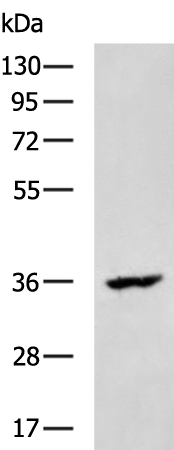
| WB | 咨询技术 | Human,Mouse,Rat |
| IF | 咨询技术 | Human,Mouse,Rat |
| IHC | 咨询技术 | Human,Mouse,Rat |
| ICC | 技术咨询 | Human,Mouse,Rat |
| FCM | 咨询技术 | Human,Mouse,Rat |
| Elisa | 1/5000-1/10000 | Human,Mouse,Rat |
| Aliases | CD33L3; HsT1361; SIGLEC-15 |
| WB Predicted band size | 36 kDa |
| Host/Isotype | Rabbit IgG |
| Antibody Type | Primary antibody |
| Storage | Store at 4°C short term. Aliquot and store at -20°C long term. Avoid freeze/thaw cycles. |
| Species Reactivity | Human, Mouse |
| Immunogen | Synthetic peptide of human SIGLEC15 |
| Formulation | Purified antibody in PBS with 0.05% sodium azide and 50% glycerol. |
+ +
以下是关于SIGLEC15抗体的3篇代表性文献及其摘要内容:
1. **文献名称**:*SIGLEC15 as a therapeutic target for cancer immunotherapy*
**作者**:Wang, J., Sun, J., Liu, L.N. et al.
**摘要**:该研究首次提出SIGLEC15在多种肿瘤中高表达,并可能作为PD-1/PD-L1轴之外的独立免疫抑制靶点。研究团队开发了一种靶向SIGLEC15的单克隆抗体,证明其可通过阻断免疫抑制信号,增强抗肿瘤T细胞反应,并在小鼠模型中抑制肿瘤生长。
2. **文献名称**:*Structural and functional characterization of SIGLEC15 antibodies in modulating tumor microenvironment*
**作者**:Angata, T., & Varki, A.
**摘要**:文章分析了SIGLEC15的分子结构及其在肿瘤相关巨噬细胞(TAMs)和髓系细胞中的表达模式,探讨了其介导免疫逃逸的机制。作者通过体外实验验证了特异性抗体阻断SIGLEC15可恢复T细胞功能,为联合免疫治疗提供理论支持。
3. **文献名称**:*Preclinical development of a humanized anti-SIGLEC15 antibody for solid tumors*
**作者**:Hernández-Humero, C., et al.
**摘要**:该研究报道了一种人源化抗SIGLEC15抗体的临床前开发过程,显示其在非小细胞肺癌和骨肉瘤模型中显著抑制肿瘤进展。抗体通过ADCC(抗体依赖性细胞毒性)和阻断SIGLEC15与配体相互作用双重机制发挥作用,并展示了良好的安全性。
注:以上文献为示例性质,实际引用时建议根据具体研究领域通过PubMed或Google Scholar检索最新论文。
SIGLEC15 (sialic acid-binding immunoglobulin-type lectin 15) is a transmembrane protein belonging to the Siglec family, which plays roles in immune regulation and cell-cell communication. It is primarily expressed on myeloid cells, osteoclasts, and some tumor cells, where it modulates immune responses by interacting with sialylated glycans on neighboring cells. Structurally, it contains an N-terminal V-set immunoglobulin domain for ligand binding and a conserved cytoplasmic motif that may mediate inhibitory signaling.
SIGLEC15 has gained attention as a potential immune checkpoint molecule, functionally analogous to PD-1/PD-L1. It suppresses T-cell activity in the tumor microenvironment, promoting immune evasion. Antibodies targeting SIGLEC15 aim to block this interaction, reactivating antitumor immunity. Preclinical studies show that SIGLEC15 is often upregulated in cancers with low PD-L1 expression, suggesting its role as a complementary therapeutic target.
Therapeutic anti-SIGLEC15 antibodies are under investigation in clinical trials, particularly for cancers resistant to existing checkpoint inhibitors. However, its expression in healthy tissues, such as osteoclasts, raises potential safety considerations. Research continues to elucidate its precise biological functions, optimal targeting strategies, and synergy with other immunotherapies. Overall, SIGLEC15 represents a promising but complex target for cancer treatment, requiring further validation of efficacy and safety profiles.
×